Linden D., Reddy T.B. (eds.) Handbook of batteries
Подождите немного. Документ загружается.


26.16 CHAPTER TWENTY-SIX
26.6.2 Manufacturing Flexibility
The power capability of a battery will affect its potential applications. A high power battery
will be capable of delivering most of its capacity in a few minutes. To maximize battery
power, it is necessary to minimize cell resistance. To that end, high power cells are designed
with high surface areas, thin electrodes and with high metallic contents. However, the above
measures will increase battery weight, volume, and cost. Given these tradeoffs, it is desirable
to optimize the cell design for the application. Thus, it is more efficient and economical to
build a cell for lower power applications utilizing thick electrodes with low metallic contents.
Practical manufacturing constraints inhibited the development of high-capacity low-rate
sintered-plate batteries. In contrast, the FNC technology covers a wide range of power ca-
pabilities. The thickness of the fiber electrode, and the amount of conductive metallic nickel
on it, are varied within an order of magnitude. This results in the capability to produce high-
capacity, low-weight, low-cost batteries or ultra-high power, higher weight, and higher cost
cells using the same processes and equipment. For the user, this means that the characteristics
of sinter foils and the various types of pocket or foam-plate batteries no longer have to be
considered separately. The FNC system has the same properties and basic characteristics
over the entire range of applications.
26.6.3 Sealed Versus Vented Designs
The charging of aqueous-nickel batteries always occurs in competition with water electrol-
ysis. Toward the end of the charging cycle, oxygen is typically evolved at the positive
electrode and hydrogen may be evolved at the negative electrode. The way that the cell deals
with these evolved gases will determine whether the cell can be sealed. In sealed cells, the
gases are recombined internally. In an open cell, the gases are allowed to vent, hence the
name vented cell.
The reactions that produce the gases are called the overcharge reactions. These reactions
differ depending on whether one deals with a sealed or vented cell.
Overcharge Reactions:
Vented (open) cell:
⫺⫺
4OH → 2H O ⫹ O ⫹ 4ePositive:
22
⫺⫺
4H O ⫹ 4e → 2H ⫹ 4OHNegative:
22
2H O → 2H ⫹ ONet:
222
The net result here is the electrolysis of water to hydrogen and oxygen.
Sealed Cell:
⫺⫺
4OH → 2H O ⫹ O ⫹ 4ePositive:
22
⫺⫺
2Cd(OH) ⫹ 4e → 2Cd ⫹ 4OHNegative:
2
2Cd(OH) → 2Cd ⫹ 2H O ⫹ ONet Electrochemical:
222
Chemical
Recombination on Negative: 2Cd
⫹ O ⫹ 2H O → 2Cd(OH)
22 2
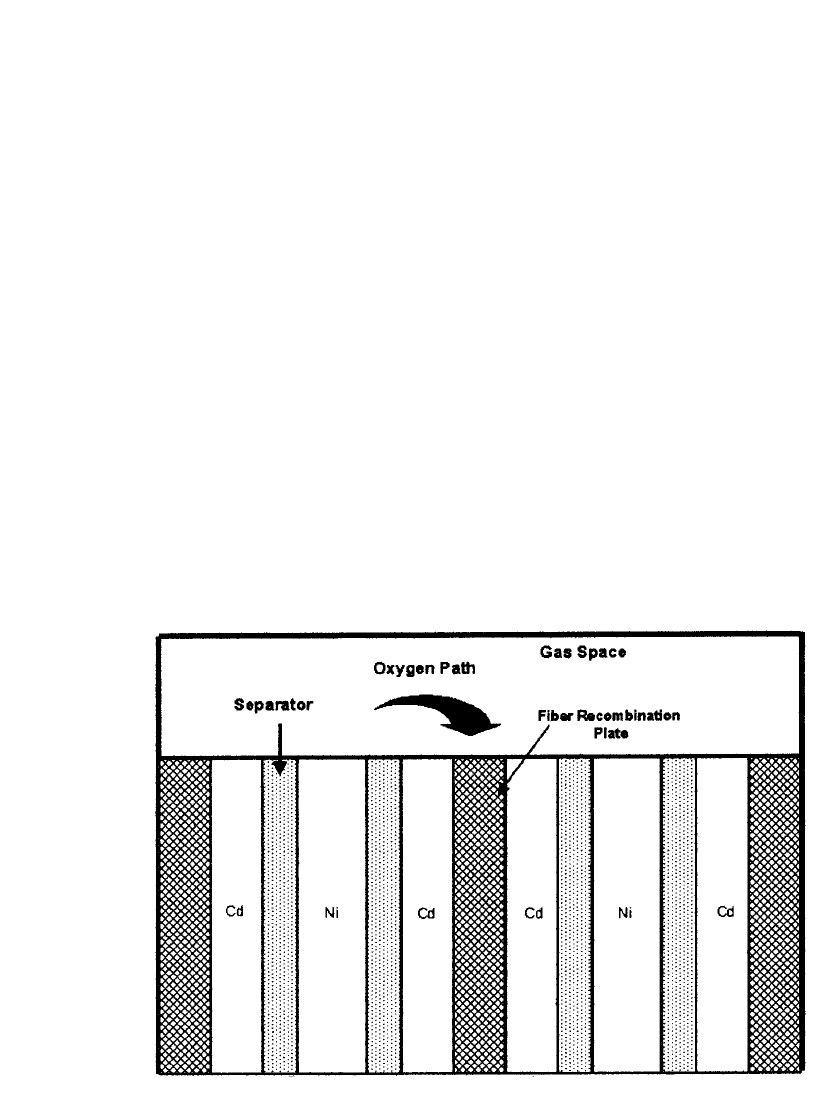
INDUSTRIAL AND AEROSPACE NICKEL-CADMIUM BATTERIES 26.17
FIGURE 26.13 Electrode structure of fiber nickel-cadmium cell.
The result in a sealed cell is that electricity is converted into heat without any net chemical
change in the cell. The overcharge reaction is exothermic, particularly the chemical recom-
bination reaction in the sealed cell.
The overcharge reaction on the positive plate starts before the cell is fully charged, so
that some oxygen evolution on charging is unavoidable. At higher temperatures, the oxygen
evolution starts at a lower voltage. This results in lower charging efficiencies at higher
temperatures and, in the case of the vented cell, an increased need for the addition of water.
Additionally, this leaves the positive plate undercharged while the negative plate continues
toward a full charged state. The resulting plate imbalance reduces battery capacity. To regain
the lost capacity, vented batteries require deep discharge conditioning with each cell being
clipped out (shorted).
26.6.4 Sealed FNC Maintenance-Free Batteries
With the development of sealed FNC technology, the first maintenance-free high rate pris-
matic nickel cadmium battery was introduced. In the sealed cell, an unfilled nickel-coated
fiber plate is placed between two cadmium filled negative plates. This effectively results in
a split negative with an unfilled central region. This inactivated section serves as a catalytic
site for rapid oxygen reduction. The main oxygen pathway to the recombination site is
through the plate pores, which, in the FNC plate construction, are relatively large. This
provides the oxygen with easy access to the large recombination reaction surfaces, as shown
in Fig. 26.13.
Because rapid oxygen recombination eliminates the pressure buildup normally associated
with sealed nickel cadmium cells, high charging rates can be sustained even in the overcharge
mode. Also, it is possible to use conventional nylon cell construction to produce prismatic
sealed cells rather than the cylindrical design required for high pressure cells. The sealed

26.18 CHAPTER TWENTY-SIX
FNC prismatic cell case is made of either polyamide (nylon) or stainless steel. The negative
pressure within the cell (approximately 0.1 bar absolute) allows for pressure change due to
oxygen generation during overcharge without causing the cell walls to expand. In addition,
the external air pressure presses the vessel walls and plate assembly together, enhancing the
hydraulic contact between the electrodes and providing mechanical rigidity. The plastic cell
cases are covered with an aluminum foil wrap which serves as a gas barrier to block the
migration of gases and water through the plastic. Many years of operation are possible
without gasses penetrating the cell, assuring the electrode materials remain active.
All nickel cadmium batteries must be overcharged to achieve a 100% state of charge.
During the overcharge stage, excessively charged portions evolve oxygen and hydrogen. In
vented batteries these gasses, along with water vapor, are vented outside the cell. The lost
liquid must be replaced. The sealed FNC battery completely eliminates the loss of any gases
from within the cell. Oxygen generated is rapidly recombined on the negative electrode.
Hydrogen evolution is avoided by excess discharged cadmium on the negative electrode.
This recombination process also keeps the plates in balance, eliminating the capacity loss
that would otherwise result. Electrolyte spillage and corrosion is completely eliminated. In
the absence of free KOH, even aluminum battery boxes may be used to reduce weight.
In the event of cell reversal or a failure to control charging voltage, hydrogen gas will
be produced. A recombination plate of Pt /Pd-catalyzed plaque located within the cell pro-
vides for hydrogen recombination. The oxygen source, for hydrogen recombination, is pro-
vided by the self-discharge reaction on the positive electrode or the overcharge reaction on
the following charge.
A safety valve at the top of the cell is provided to allow excessive pressure to escape
should the battery be abused to the point that the electrolyte boils. This condition might be
caused by a severe overcharge where adequate heat dissipation is not provided. Under high
temperature abuse (
⫹100⬚C and above), the safety valve will open at approximately 45 psia
over pressure allowing water vapor to escape. Electrolyte will not be expelled, even with the
cell in an inverted position. When the cell is allowed to cool, the valve will reseal and the
negative pressure cell will return to a normal operating condition. A reduction in cell capacity
may be anticipated due to the loss of water from within the cell.
A high negative to positive capacity ratio (in excess of 2:1) is employed in the cell design.
This high excess of negative capacity allows for fast charge without hydrogen evolution over
a wide range of temperatures. The excess negative capacity also provides for high power at
low temperature. Forming the electrodes prior to stack assembly in order to minimize the
carbonate level within the sealed FNC cell further increases low temperature performance.
Positive and negative plates are connected to their respective terminal posts by nickel
tabs. The tabs are attached directly to the fiber plates by a patented welding process and
then fastened directly to nickel-plated, solid-copper terminal posts. The electrical path of
each cell type is designed for maximum electrical performance.
Plate stacking is the same as previously discussed. Single positive plates are separated
from the negative cadmium electrode by an electrolyte wet separator. The cadmium electrode
is in three parts: two fiber frameworks carrying the negative active material, and an unfilled
fiber recombination electrode placed between them. The large recombination surface area is
sufficient to handle a 2 C rate charge on a fully charged battery. With the unfilled recom-
bination plate being the primary gas path for oxygen recombination, small pore size separator
can be used. The separator is designed to be completely filled with electrolyte, thus contrib-
uting to improved high rate performance. Additionally, the recombination plate acts as a
reservoir for electrolyte, allowing for volumes in excess of 4 ml /Ah. This prevents stack
dry-out as a possibility for premature cell failure.
Sealed FNC batteries are fail-safe. Even if subjected to extreme overcharge to the point
at which the electrolyte boils, the battery will not go into thermal runaway. Instead, the hot
cells dry out, with the loss of water vapor causing the battery impedance to increase. As the
impedance increases, the current will decrease. After a time, the battery will no longer accept
the charge current and it will cool down.
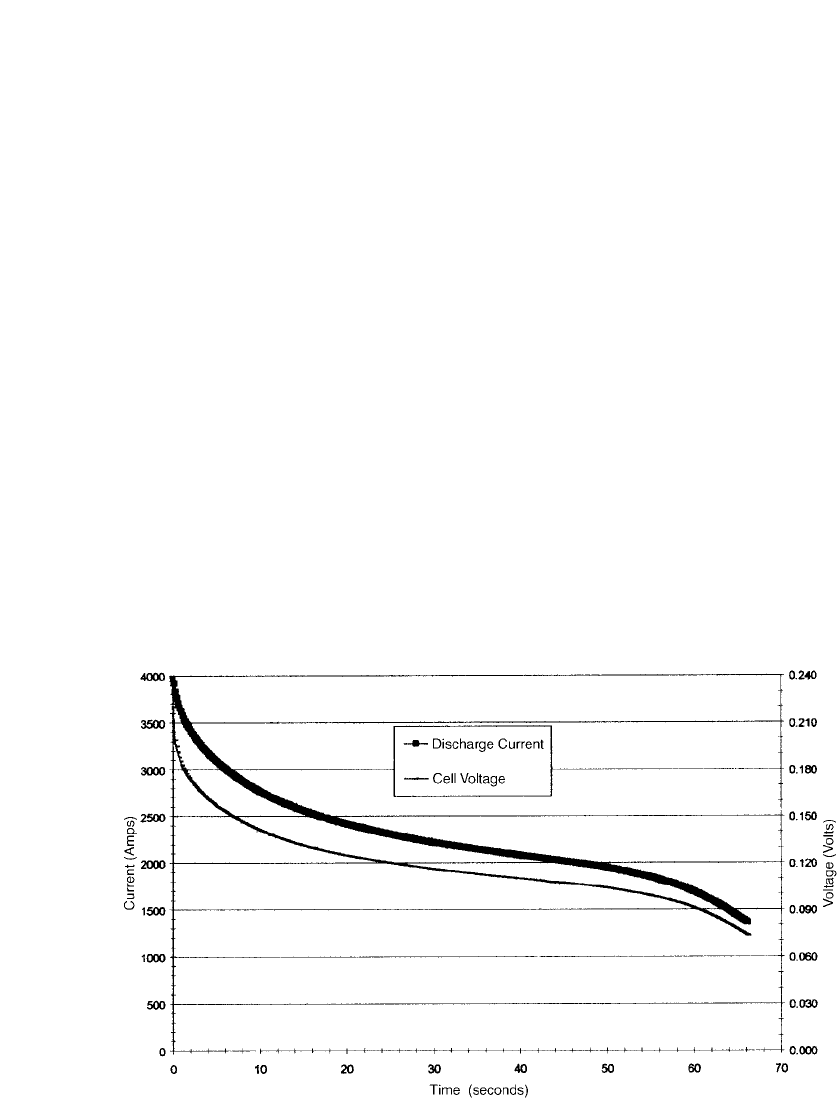
INDUSTRIAL AND AEROSPACE NICKEL-CADMIUM BATTERIES 26.19
FIGURE 26.14 Short circuit current. Model KCF XX47 cell (47 Ah rated).
26.6.5 Performance
The high current performance capability of the sealed FNC battery design is exemplified by
a short circuit test performed on a model KCF XX47 battery which produced currents ap-
proaching 4000 amps (see Fig. 26.14). The KCF XX47 unit was designed to meet the
requirements for large auxillary power unit (APU) and direct engine starting. The constant
voltage discharge of 12 V demonstrates the extraordinary high power capability of the battery
(see Fig. 26.15). The KCF XX47 battery’s high power performance is also demonstrated
with start curves for a large, wide-body aircraft APU. The first two discharge sequences
represent unsuccessful start attempts with the third showing a successful start. The minimum
voltage required for this particular specification is 13 V, while the FNC battery provides over
16 V (see Fig. 26.16).
Cold temperature performance available with the sealed FNC cells is also impressive.
Fig. 26.17 shows the capacity of a 28 V 47 Ah battery for four different discharge rates with
the battery soaked at a temperature of
⫺18⬚C.
Sealed FNC batteries have shown outstanding cycle life at both low and high rates of
discharge. Figure 26.18 provides cycle life data for Low Earth Orbit (LEO) cycle testing.
The data demonstrates a cycle life in excess of 10,000 cycles for 35% DOD, 10
⬚C, C/2
cycling. By maintaining the stable end of discharge voltage, the low recharge coefficient
(approximately 3%) demonstrates the superior charge efficiency of the sealed FNC cell.
Deep discharge cycling is not necessary, eliminating the necessity for battery removal
from the aircraft during maintenance. Capacity checks, if desired, can be accomplished with
the battery installed by using a portable discharge/charger unit because the sealed FNC
design does not exhibit the memory effect typically found in other NiCd’s. This is illustrated
in Fig. 26.19 which consists of three capacity checks taken after 7845 60% DOD LEO
cycles. The first capacity is directly out of orbital cycling at approximately the C rate. The
second capacity value is after a full recharge (C/10 for 16 hours) and C/ 2 discharge. The
third capacity value is after a resistive let down and subsequent full recharge. Of particular
importance is the shallow voltage depression that occurs around 48 Amp-hours into the
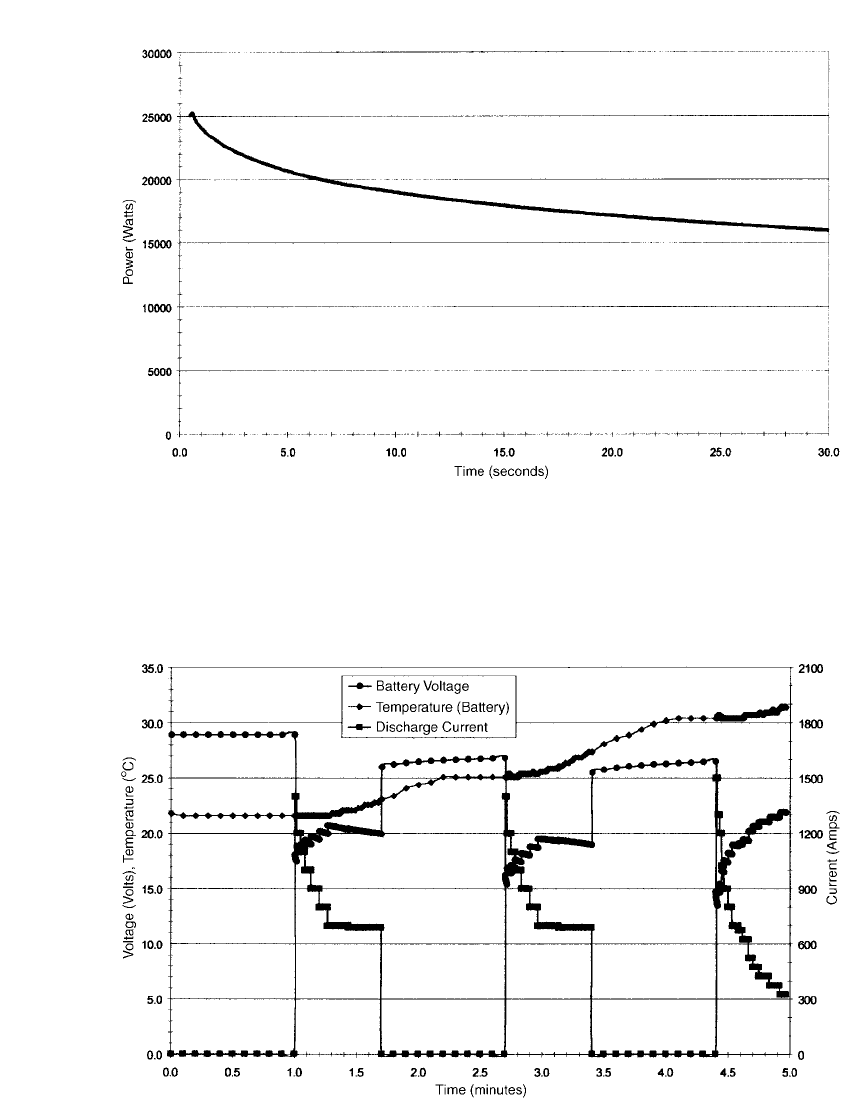
26.20 CHAPTER TWENTY-SIX
FIGURE 26.15 Constant voltage (12.0 Volts) discharge. Room temperature. Model XX47 battery (47 Ah
rated).
FIGURE 26.16 APU starts: 2 unsuccessful, 1 successful. Model XX47 battery (47 Ah rated).
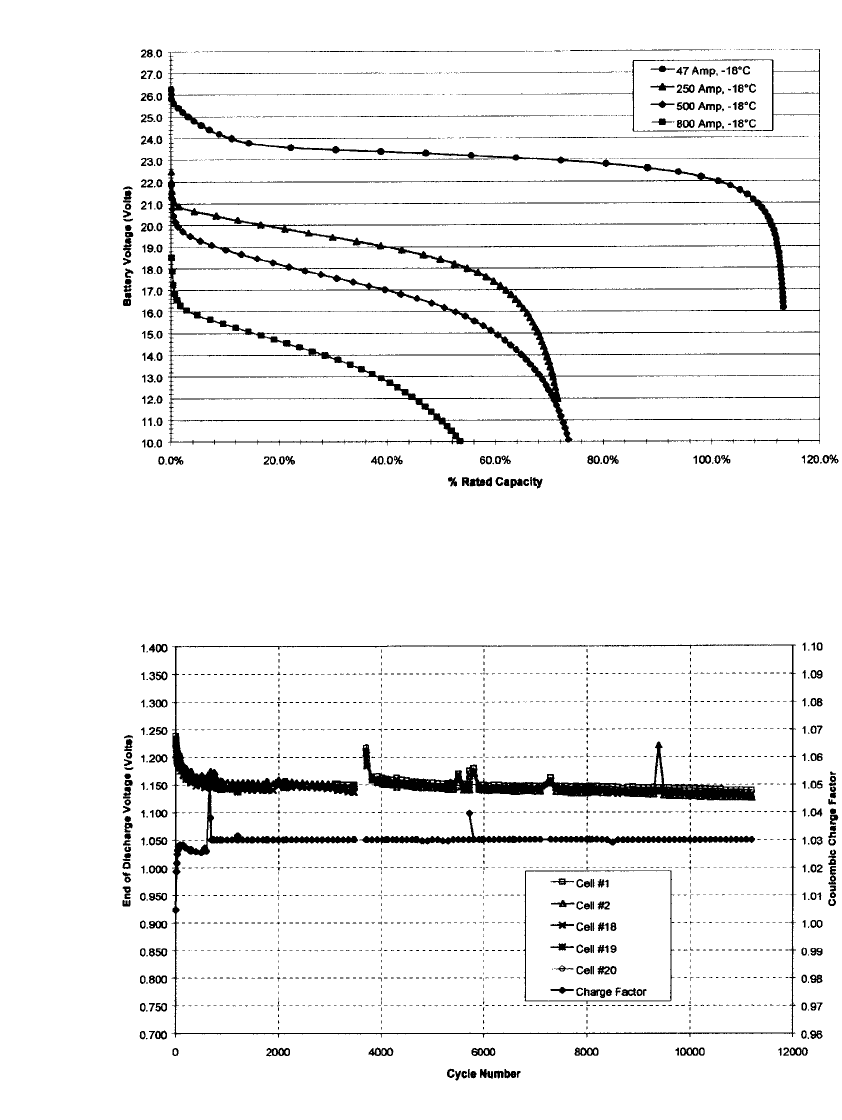
INDUSTRIAL AND AEROSPACE NICKEL-CADMIUM BATTERIES 26.21
FIGURE 26.17 Constant current discharge. Battery charged at 25⬚C. Battery discharged at ⫺18⬚C. Model
XX47 battery (47 Ah rated).
FIGURE 26.18 LEO cycles, 35% DOD, 92 minute orbit. Model KCF X81 (81 Ah rated) battery. 10⬚C
ambient temperature. End of discharge voltage and coulombic charge factor.
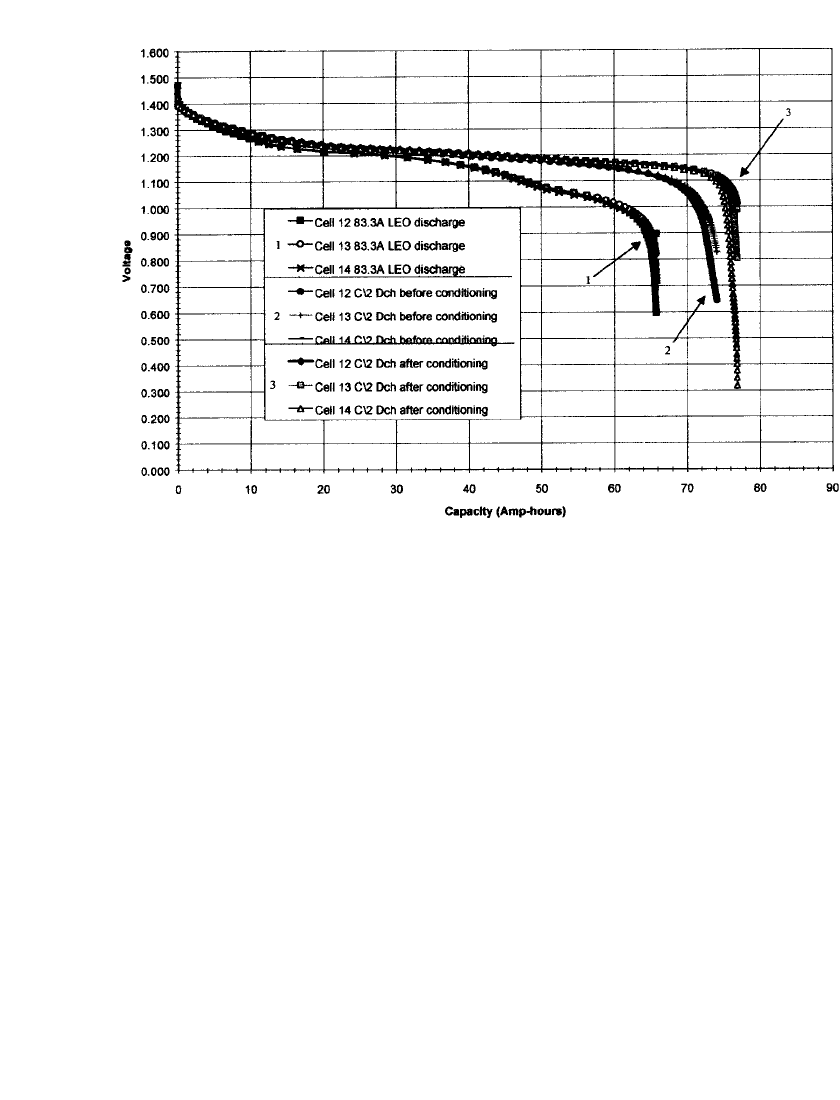
26.22 CHAPTER TWENTY-SIX
FIGURE 26.19 Capacity checks after 7845 LEO cycles, 60% DOD. Out of orbital capacity, before condi-
tioning, after conditioning. Model KCF X81 (81 Ah rated). 10⬚C ambient temperature.
discharge, the point where the prior cycles discharge had ended. After 7845 cycles, the cell
continued to discharge pasts this point to an out of orbital capacity of 68 Amp hours.
Charging characteristics of the sealed FNC cells are simple, yet different from vented
NiCds. Because of the recombination that takes place during overcharge, the normal dV /dt
behavior is not always observed. In addition, heat is generated during the overcharge from
the recombination reaction, providing a reliable parameter for charge control. Changing from
main mode to topping mode and charge termination is determined by battery temperature
rise (
⌬ T).
The preferred charge is at constant current with a voltage clip (maximum voltage) of 1.55
V per cell. This provides an excellent charge rate while keeping the voltage below the level
where both hydrogen and oxygen would be generated. This voltage is also sufficient to charge
the battery at temperatures as low as
⫺40⬚C. For many applications, this means that a heater
blanket is not required.
A completely charged FNC battery has sufficient recombination to continue to accom-
modate a 2 C overcharge rate. Even higher rates are possible with the battery in a lower
state of charge. A 200 Amp, 47 Ah cell charge profile is shown in Fig. 26.20. Voltage,
current and temperature curves are shown for the charge sequence. The discharge voltage
curve indicates the cell capacity following the 200 Amp charge.
The superior recombination rate of the oxygen produced in overcharge is demonstrated
in Fig. 26.21. Internal cell pressure was taken at three different temperatures for a C rate
charge. Note that at the end of charge and into overcharge, the internal pressure is well
below atmospheric pressure.

INDUSTRIAL AND AEROSPACE NICKEL-CADMIUM BATTERIES 26.23
FIGURE 26.20 4C (200 amp) Charge. 1 C discharge. Model KCF XX47 Battery (81 Ah rated).
FIGURE 26.21 Cell internal pressure and current for 35% DOD accelerated LEO cycle. Model KCF X81
battery (81 Ah rated).

26.24 CHAPTER TWENTY-SIX
26.7 MANUFACTURERS AND MARKET SEGMENTS
Table 26.3 contains data regarding prominent manufacturers of industrial nickel-cadmium
batteries, Table 26.4 lists the market segments and applications for these batteries.
TABLE 26.3 Major Manufacturers of Industrial and Aerospace Nickel-Cadmium Batteries (Does Not
Include Sintured-Plate Designs—See Chap. 27)
Manufacturer/ country
Product range
Trademark Pocket-plate Fiber plate Plastic-bonded plate
Acme Electric, U.S.A Acme X
Alcad Ltd., U.K. Alcad X
HBL-NIFE Power Systems, India HBL X
Hoppecke Batterien, Germany Hoppecke X
Japan Storage Battery, U.S.A. GS X X
Marathon Battery, U.S.A. Marathon X X
SAFT, S.A., France SAFT X X
Tudor S.A., Spain Tudor X X
Varta, Germany Varta X
Yuasa, Japan Yuasa X
Table 26.5 lists parameters of one line of standard sealed FNC cells currently manufac-
tured. As detailed in the prior text, the manufacturing processes and cell design have the
flexibility to develop capacities and packaging to fit a variety of application.
Figure 26.22 is a picture of a 28 V, 47 Ah airborne battery system with battery and
dedicated charger which uses the model XX47 unit described in Table 26.5.
Table 26.6 lists the characteristics of a second line of sealed FNC batteries which are
available in X, H, M and L designs. These operate with lower pressure vents than the batteries
listed in Table 26.5.

26.25
TABLE 26.4 Market Segments and Applications for Vented Industrial Nickel-Cadmium Batteries
Cell range*
Pocket plate
HM L
Fiber plate
XX H or X M L
Plastic-bonded
plate
HM
Capacity, Ah 10–1000 10–1250 10–1450 23–47 10–220 20–450 20–490 11–190 20–200
Applications UPS,
starting,
switchgear
UPS,
switchgear,
auxiliary
power,
emergency
power
Lighting, alarms,
signalling,
communications,
standby power
Aircraft UPS, satellites,
starting,
switchgear,
traction, power
stations and
substations
UPS,
switchgear,
auxiliary
power,
emergency
power
Lighting, UPS,
alarms, signalling,
telecommunications,
standby power
UPS,
starting,
switchgear,
traction,
aircraft
Lighting,
auxiliary
power,
traction
Railroad X X X X X X X X
Mass transit X X X X X X X X
Industry X X X X X X X
Buildings X X X X X X X
Hospitals X X X X X X X
Oil and gas X X X X X X X
Airports X X X X X X X
Marine X X X X X X X X
Military X X X X X X X X
Telecommunications X X X X X X X
Photovoltaics X X
AGV / hybrid vehicles XX
X-H—high rate; M—medium rate; L—low rate.
XX—ultra high-rate.
